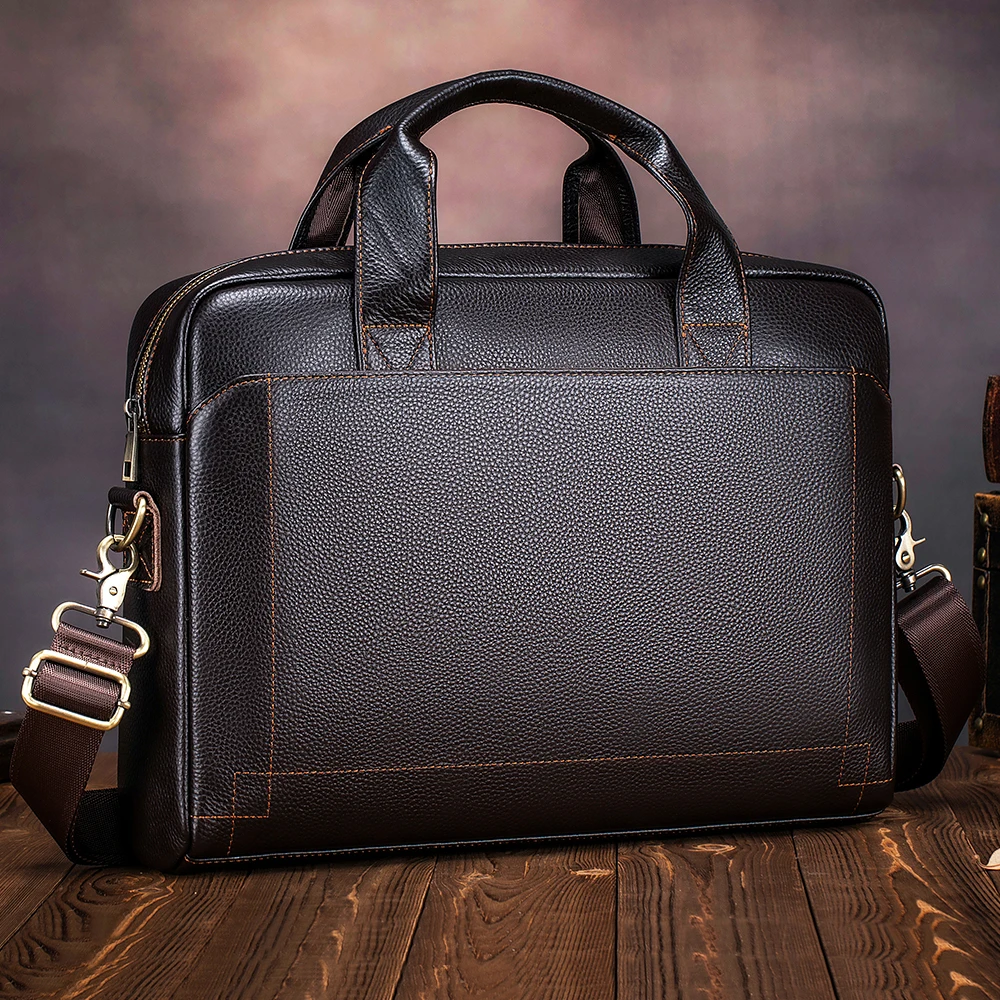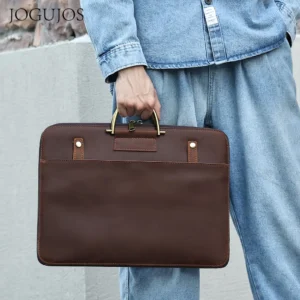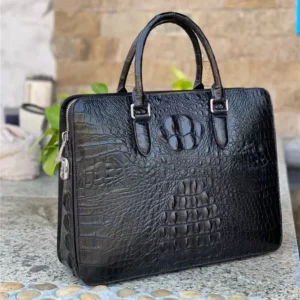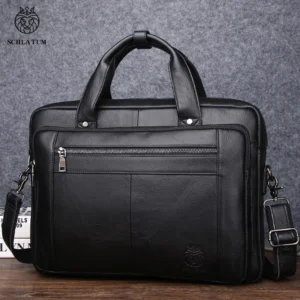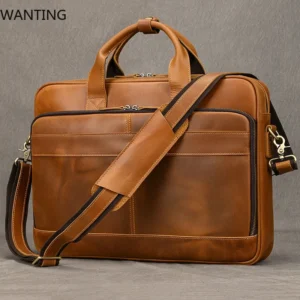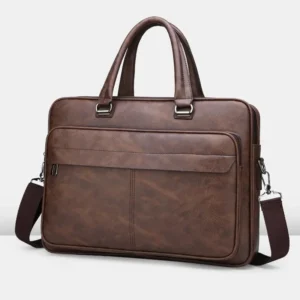Introduction: Understanding the Leather Color Dilemma
When it comes to formal settings, the choice between brown and black leather isn’t merely about personal preference—it’s about understanding subtle yet powerful dress codes that can influence how others perceive you. This age-old debate has perplexed professionals for generations, leaving many wondering when to choose which color and whether traditional rules still apply in modern contexts.
The once-strict “no brown in town” rule that dominated British professional dress codes has evolved significantly, but navigating formal leather etiquette remains important for anyone seeking to make the right impression. Both colors have their rightful place in formal settings, but their appropriateness depends on specific factors including the occasion, accompanying attire, and even regional expectations.
At Poise Porter, we understand that premium leather goods are an extension of your professional identity. Through this comprehensive guide, we’ll help you confidently navigate the leather color dilemma across various formal occasions, balancing time-honored traditions with contemporary interpretations. The perfect leather choice can elevate your entire ensemble, while the wrong one might send unintended signals about your attention to detail.
Understanding the nuances of black and brown leather briefcases and accessories will empower you to make informed decisions that enhance your professional presence.
The Essential Differences: Black vs. Brown Leather at a Glance
Before diving into specific scenarios, let’s establish the fundamental distinctions between these two classic leather options:
| Feature | Black Leather | Brown Leather |
|---|---|---|
| Formality Level | Highest formal ranking | Varies by shade (dark brown being most formal) |
| Best Formal Occasions | Black/white tie events, formal business meetings, funerals | Business formal (industry dependent), formal daytime events |
| Perception | Traditional, authoritative, sophisticated | Approachable, versatile, contemporary elegance |
| Advantages | Universally accepted as formal, pairs easily with formal attire | Greater versatility across suit colors, adds warmth and character |
| Limitations | Can appear severe or conventional | Light shades may be considered too casual for ultra-formal settings |
While black leather maintains its position as the most formal option, dark brown leather offers sophisticated versatility that has gained increasing acceptance in formal settings. The formality of brown leather exists on a spectrum—the darker the shade, the more formal it generally appears. Cognac, tan, and light brown typically read as more casual, while deep chocolate and oxblood-tinged brown can approach black’s formality level in many contexts.
It’s worth noting that industry standards significantly influence what’s considered appropriate. Traditional sectors like finance, law, and diplomacy tend to favor black leather in formal settings, while creative industries and technology firms often embrace the versatility of brown.
Determining which color briefcase is most professional often depends on your specific industry and the impression you wish to convey. For consistently formal environments, our selection of black leather briefcases provides classic elegance that aligns with traditional expectations.
Traditional Rules vs. Modern Interpretations: How Formality Standards Have Evolved
The traditional “no brown in town” rule originated in early 20th century British business culture, where black leather was exclusively appropriate for city professionals, while brown was relegated to country and casual settings. This stark division reflected clear class distinctions and rigid professional expectations of the era.
Today’s global business landscape has significantly relaxed these boundaries. Modern interpretations of formal dress codes have expanded to embrace dark brown leather as appropriate in many professional settings, provided it coordinates properly with the rest of your ensemble. This evolution reflects broader shifts toward individual expression and comfort within professional environments.
Nevertheless, certain settings maintain stricter adherence to traditional standards:
- Investment banking and high finance
- Diplomatic functions and government formalities
- Law courts and traditional legal settings
- Black-tie and white-tie events
- Funerals and solemn ceremonies
In these contexts, black leather remains the safest and most appropriate choice. However, in many corporate environments, dark brown leather has gained acceptance as a sophisticated alternative that conveys both professionalism and personal style.
The modern professional can confidently incorporate both colors into their wardrobe, understanding that the choice between brown and black professional briefcases should be guided by the specific context rather than rigid universal rules. Your leather style choices make subtle statements about your approach to tradition and contemporary professional norms.
Choosing by Occasion: When to Wear Black vs. Brown Leather
Selecting the appropriate leather color requires understanding the specific expectations of different formal settings. Here’s a detailed breakdown to guide your choices:
Black/White Tie Events
Black Leather Required
These ultra-formal occasions represent the pinnacle of formality. Black patent leather shoes are traditional, and all other leather accessories should be black to maintain the elegant uniformity these events demand.
Business Formal Settings
Black Preferred in Conservative Industries
Traditional sectors like banking, law, and consulting still favor black leather, especially for client meetings and significant presentations. However, dark brown has become increasingly acceptable in many corporate environments, particularly when paired with navy or gray suits.
Industry Variations: Creative fields, technology, and modern businesses generally allow more flexibility, making dark brown leather entirely appropriate for even important formal meetings.
Formal Weddings
Evening: Black Preferred
For evening weddings with formal dress codes, black leather coordinates best with the darker, more formal attire typical of such events.
Daytime: Brown Acceptable
Daytime formal weddings, especially those in spring or summer, are perfectly suitable occasions for dark brown leather shoes and accessories, particularly when wearing navy, blue, or gray suits.
Funerals and Solemn Occasions
Black Strongly Preferred
Out of respect for the gravity of these events, black leather remains the most appropriate choice regardless of region or personal style preferences.
Upscale Social Events
Both Colors Appropriate (Context Dependent)
For formal restaurant dinners, theater attendance, or upscale social gatherings, either color works well depending on your overall outfit. Evening events tend to favor black, while daytime functions allow for brown leather.
Regional expectations also influence what’s considered appropriate—European formal standards often embrace dark brown leather more readily than some traditional American settings, particularly in cities with deep historical business traditions.
Our collection of brown leather briefcases offers distinguished options for professionals who understand when brown leather can make the perfect formal statement.
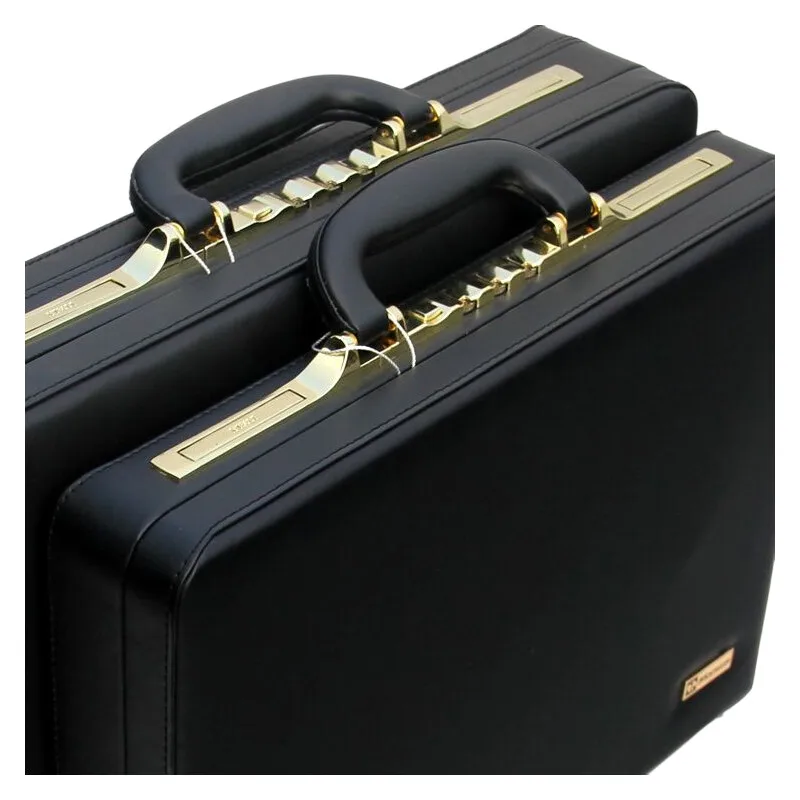
The Perfect Match: Pairing Leather Colors with Formal Attire
Formal Shoes: Foundation of Your Look
The shoes you select create the foundation of your formal appearance, with distinct pairing guidelines for each leather color:
Black Leather Shoes
– Ideal suit pairings: Black, charcoal, and very dark navy suits
– Most formal styles: Oxford shoes (especially wholecuts and cap-toes)
– Universal acceptance: Appropriate for all formal occasions
– Finish matters: High-polish finish reads as most formal
Brown Leather Shoes
– Optimal suit pairings: Navy, medium to light grey, blue, and patterned suits
– Appropriate formal styles: Dark brown Oxfords are acceptable for most business formal settings
– Shade significance: Dark chocolate brown approaches black in formality; tan and cognac read as significantly less formal
– Modern appeal: Offers sophisticated versatility while maintaining professionalism
The shoe style itself also influences formality regardless of color. Oxford shoes (with closed lacing) are most formal, followed by Derby shoes (with open lacing), while monk straps occupy a middle ground. For the highest level of formality, a black Oxford with minimal ornamentation remains the gold standard.
Leather Belts and Accessories: Creating Harmony
In formal settings, coordination between leather accessories is essential:
The Belt-Shoe Match
The cardinal rule of formal dressing requires that your belt color precisely matches your shoes. This creates visual harmony and demonstrates attention to detail. In ultra-formal settings, belts should be slim (1-1.25 inches) with minimal buckles—preferably in a matching metal tone to other accessories.
Briefcases and Portfolios
Your leather briefcase should ideally match your shoes and belt in formal business settings. A black briefcase remains the most conservative choice for traditional formal environments, while dark brown offers sophisticated versatility for modern professional contexts.
Watch Straps and Small Leather Goods
For complete formal harmony, your watch strap should complement your other leather items. In the most formal settings, consider a simple black leather strap or a metal bracelet watch. Wallets and cardholders, though rarely visible, should ideally coordinate with your overall leather scheme.
Understanding how to match your leather briefcase color to your outfit demonstrates refined style awareness. For professionals seeking timeless options, our classic leather briefcases for men provide sophisticated selections for various formal contexts.
First Impressions: What Your Leather Color Communicates
Beyond merely following dress codes, your leather color choice conveys subtle psychological messages that influence how others perceive you in formal settings:
Black Leather Signals:
– Authority and confidence
– Traditional values and respect for convention
– Seriousness and formality
– Precision and attention to detail
– Classic sophistication
Brown Leather Conveys:
– Approachability paired with professionalism
– Contemporary style awareness
– Versatility and adaptability
– Subtle individuality within formal boundaries
– Warmth and authenticity
Understanding these impressions allows you to strategically select leather colors based on the specific impression you wish to make. In client-facing roles where establishing authority is paramount, black leather reinforces your expertise. For collaborative environments where building rapport is essential, dark brown leather maintains professionalism while appearing more approachable.
Different professional environments interpret these signals distinctly. Conservative industries tend to value the traditional authority of black leather, while creative and progressive fields often appreciate the nuanced personality expressed through thoughtfully selected brown leather goods.
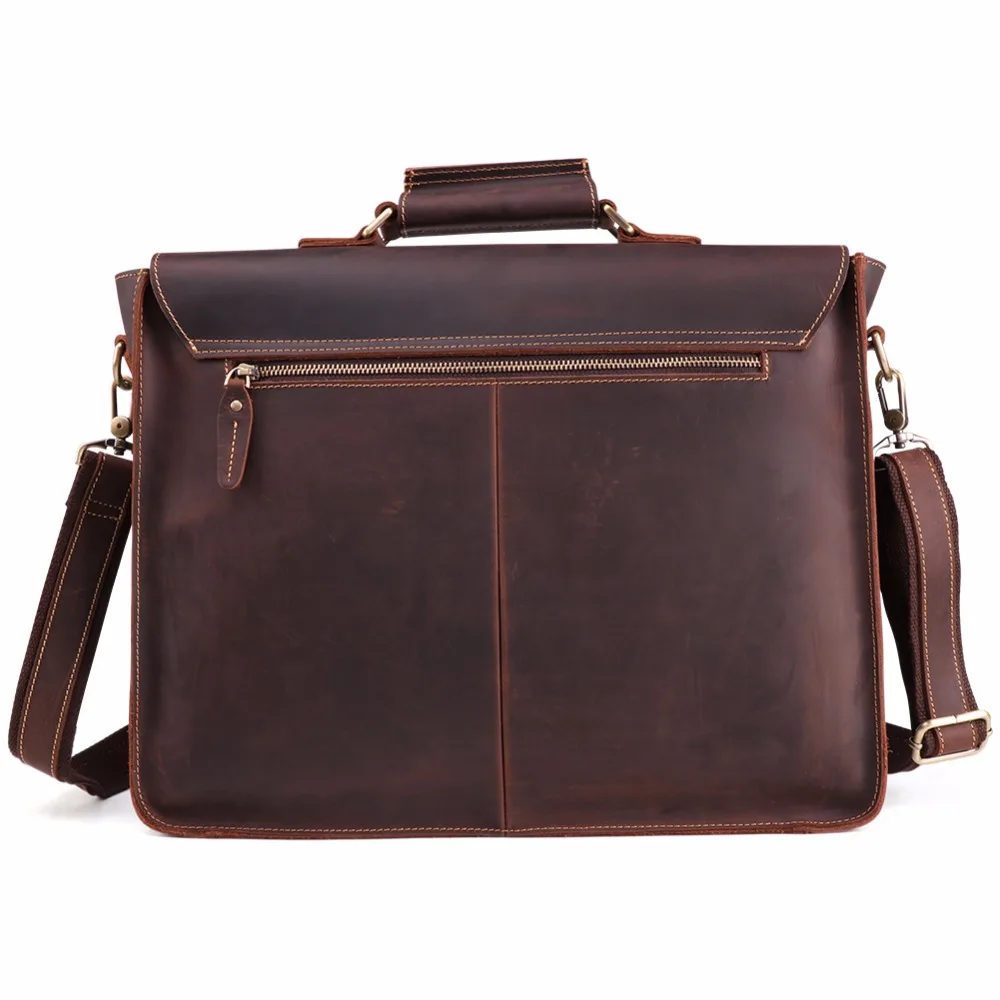
The psychological impact of black versus brown leather bags extends beyond mere aesthetics—it subtly influences the professional dynamic you establish from the first handshake.
Common Mistakes: Leather Faux Pas to Avoid in Formal Settings
Even well-intentioned professionals sometimes make leather missteps that undermine their formal appearance. Here are critical mistakes to avoid:
Mismatching shoes and belts: This fundamental error immediately signals inattention to detail. In formal settings, these leather items should match in both color and finish.
Wearing light brown leather to highly formal occasions: Light tan or cognac leather, regardless of quality, is inherently too casual for black-tie events, formal business meetings, or solemn ceremonies.
Pairing brown shoes with black suits: This combination creates jarring visual disharmony. Black suits demand black leather shoes and accessories in formal contexts.
Ignoring explicit dress codes: When an invitation specifies black tie or a company mandates particular dress standards, these supersede personal preferences about leather colors.
Using worn or poor-quality leather: In formal settings, the condition of your leather speaks volumes. Scuffed, cracked, or obviously artificial leather compromises even perfectly coordinated formal attire.
Selecting inappropriate finishes: Formal occasions generally call for polished leather finishes. Suede, nubuck, or heavily distressed leather, regardless of color, reads as too casual for formal settings.
To correct these mistakes, invest in quality matching sets of both black and dark brown formal leather goods, properly maintain them, and always consider the specific expectations of each formal occasion before selecting which to wear.
Our slim leather briefcases offer refined options that help avoid common formal leather missteps through their elegant design and quality construction.
Building Your Formal Leather Collection: Essential Investments
For professionals who regularly navigate formal settings, strategically building a comprehensive leather collection ensures you’ll always have appropriate options. Here are the core formal leather items worth investing in:
- Black Oxford dress shoes – The foundation of any formal wardrobe
- Dark brown Oxford or Derby shoes – For versatile formal-to-business wear
- Matching slim belts in both colors – Essential coordination pieces
- Quality leather briefcase or portfolio – A daily ambassador of your professional style
- Leather watch strap(s) – Subtle but noticeable detail piece
If budget constraints require prioritization, invest first in high-quality black leather shoes and a matching belt, as these will serve the broadest range of formal occasions. Next, add a professional black leather briefcase that will maintain its appearance for years. As resources permit, expand with dark brown leather items that increase your versatility.
Men's Classic Leather Briefcase, Slim Leather Laptop Briefcase, Slim Leather Portfolio Briefcase
$93.67 Select options This product has multiple variants. The options may be chosen on the product pageClassic Laptop Briefcase, Men's Classic Leather Briefcase, Slim Leather Attache Case
Price range: $353.50 through $360.81 Select options This product has multiple variants. The options may be chosen on the product pageBlack Leather Briefcase, Leather Document Bag, Men's Classic Leather Briefcase
Genuine Crocodile Leather Executive Briefcase with Password Lock – Premium Business Document Carrier$1,201.87 Select options This product has multiple variants. The options may be chosen on the product pageBlack Leather Briefcase, Classic Laptop Briefcase, Men's Classic Leather Briefcase, Slim Leather Laptop Briefcase
$228.72 Select options This product has multiple variants. The options may be chosen on the product pageBrown Leather Briefcase, Classic Laptop Briefcase, Crazy Horse Leather Satchel, Men's Classic Leather Briefcase
Price range: $172.15 through $200.02 Select options This product has multiple variants. The options may be chosen on the product pageMen's Slim Leather Briefcase, Slim Leather Laptop Briefcase, Vegan Leather Briefcase
Price range: $120.82 through $131.11 Select options This product has multiple variants. The options may be chosen on the product page
Quality indicators for formal leather goods include full-grain leather, tight stitching, smooth linings, and hardware that feels substantial. Premium leather develops a rich patina with proper care, actually improving in appearance over time—making quality formal leather items true investments rather than mere purchases.
The versatility benefits of owning both black and dark brown formal leather options cannot be overstated, as they allow you to appropriately navigate the full spectrum of professional and formal social occasions.
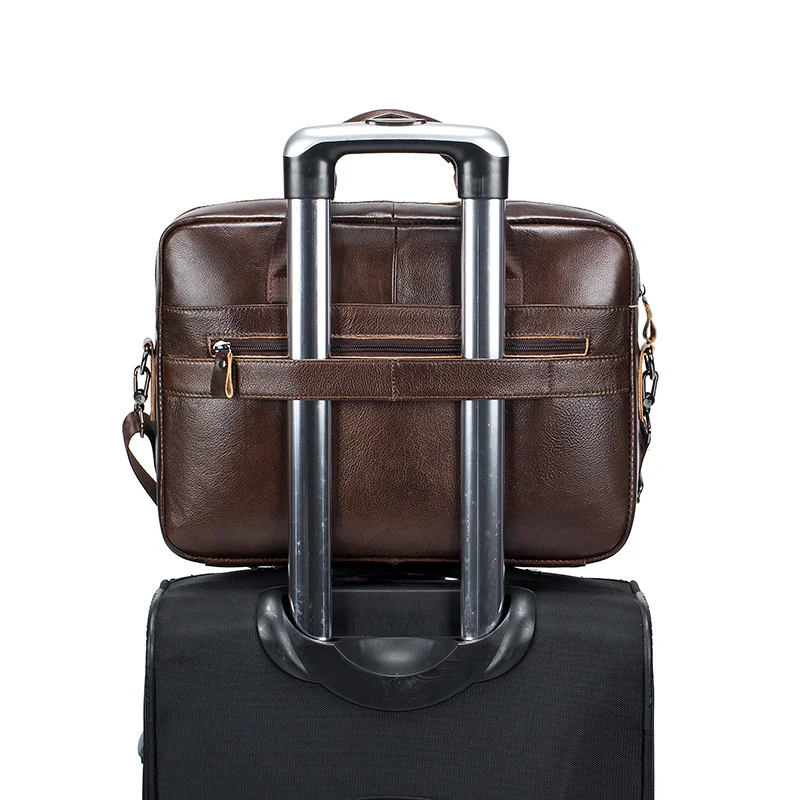
Our collection of classic leather briefcases represents the ideal foundation for a professional leather collection, offering timeless designs crafted to last through countless formal occasions.
Beyond the Basics: Burgundy and Oxblood as Formal Alternatives
While the black and brown leather debate dominates formal considerations, burgundy and oxblood leather offer sophisticated alternatives worth exploring. These rich, deep reddish-brown tones occupy a unique position in the formality spectrum—typically falling between black and brown in terms of traditional acceptance.
Burgundy and oxblood leather possess remarkable versatility in formal settings. They pair excellently with navy, gray, and tan suits, adding subtle distinction while maintaining appropriate formality. These colors work particularly well in legal, academic, and creative professional environments where refined individuality is valued.
For formal occasions, these alternative colors are most appropriate when:
– The setting is formal but not ultra-formal (business formal rather than black tie)
– You’re wearing navy, medium-to-light gray, or tan suits
– The event occurs during daytime or early evening
– You’re confident in your style choices and the specific environment’s receptiveness
Coordinating these colors requires thoughtful attention—matching your belt precisely to your shoes becomes even more important with distinctive leather colors. Other accessories like briefcases in these colors make powerful statements while remaining within formal boundaries when well-crafted and properly styled.
Selecting the best leather color for your work bag might lead you beyond the black-brown binary to these distinguished alternatives that offer professional distinction while honoring formal expectations.
FAQ: Your Leather Formality Questions Answered
Can brown shoes ever work with a black suit in formal settings?
In strictly formal settings, no. This combination breaks a fundamental rule of formal dressing. Black suits should always be paired with black leather shoes and accessories. However, in less formal or creative professional environments, very dark brown shoes might occasionally work with a black suit, though it remains a bold choice that requires confidence.
Are brown dress shoes inherently less formal than black ones?
Yes, traditionally speaking. Black leather has historically represented the highest level of formality. However, the formality gap narrows significantly with dark brown shoes in well-crafted formal styles like Oxfords, especially in contemporary professional contexts.
What specific shade of brown works best for formal occasions?
Dark chocolate brown approaches black in formality while offering more versatility. The darker the brown, the more formal it reads. Avoid tan, cognac, or light brown for truly formal settings.
Do I need both black and brown formal leather items?
For a complete professional wardrobe, yes. Black leather covers the most formal occasions and conservative environments, while quality brown leather offers versatility across most business and formal daytime events. Together, they provide options for any formal setting.
How important is shoe style compared to color for formality?
Both factors significantly impact formality. An Oxford in black represents peak formality, while even black loafers read as less formal. Similarly, brown Oxfords typically appear more formal than black loafers. The combination of conservative style and appropriate color creates the most formal impression.
How do regional differences affect leather color formality rules?
European business centers, particularly in Italy and parts of France, embrace brown leather in formal settings more readily than traditional American or British environments. Urban-rural differences also exist, with metropolitan areas typically maintaining more conservative leather expectations for formal occasions.
Making the final decision between black and brown leather bags requires balancing traditional expectations with your specific context and personal style—all while maintaining appropriate formality for each occasion you encounter.

